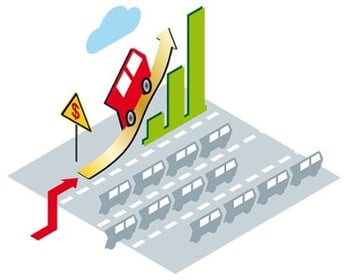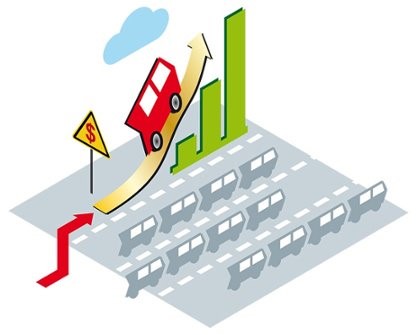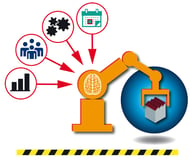The Impact of Machine Learning on Shipping and Freight Forwarding
Brian Hoey - April 30, 2019

 Let’s talk about Sherlock Holmes for a second. When you think of this famous English detective, a few things probably come to mind: his iconic deerstalker cap, maybe his pipe or his violin, and his magnifying glass—that critical tool for finding clues that Scotland Yard might have missed. Though Holmes was a fictional construct, sprung from the mind of Sir Arthur Conan Doyle, the method he employed in his stories and novels actually had a real-world impact on how detective work and criminal investigations were conducted in the 20th century.
Let’s talk about Sherlock Holmes for a second. When you think of this famous English detective, a few things probably come to mind: his iconic deerstalker cap, maybe his pipe or his violin, and his magnifying glass—that critical tool for finding clues that Scotland Yard might have missed. Though Holmes was a fictional construct, sprung from the mind of Sir Arthur Conan Doyle, the method he employed in his stories and novels actually had a real-world impact on how detective work and criminal investigations were conducted in the 20th century.
His famous magnifying glass, for instance, was not something that had been used to solve crimes before the first of his stories came along. And yet, when the tool was at last adopted by real-life detectives, they proved extremely useful. Why? For the fairly obvious reason that they enabled users to see the world in a more granular level of detail—and thus draw conclusions between a more complex array of factors—than would be possible with the naked eye. In this way, Holmes’ magnifying glass is a little bit like machine learning in the supply chain. Both give users the ability to draw conclusions from data that would have otherwise remained unhelpful or obscure.
And just as Holmes and his magnifying glass changed police work, so too is machine learning changing the face of the shipping and freight forwarding industries.
What Defines a Successful Supply Chain?
For background, machine learning is a process by which large caches of data are analyzed in order to find connections between different elements that human analysts would be unlikely to discover. This technology powers things like automated spam detection in emails, but it’s also increasingly being applied to areas like supply chain management that, by their very nature, produce large amounts of data. For shippers and freight forwarders, this can include things like past orders (including pricing, customer requirements, routes taken, volumes moved, timetables, etc.) as well as real-time information from elsewhere in the supply chain. This data is then centralized and fed into an algorithm that can yield mission critical insights into current and future operations.
Though this takes many different forms, the general idea is that, with this technology in tow, shippers and freight forwarders can begin to pinpoint the factors that contribute to a successful supply chain. For instance, by examining the geographical distribution of your customer base, you might be able to uncover the ideal structure for your transport network, i.e. the optimal placement of hubs, cross-docks, warehouses, etc. Similarly, you might analyze container usage in order to determine the appropriate number and distribution of containers at various touch points in your network. In each of these instances, you’re letting the past successes and failures of your supply chain guide you towards areas of potential improvement or optimization. Rather than guessing at the effect that any change in your network might produce, you can home in on the factors that determine success and optimize those elements accordingly.
Making Predictions
Let’s get a little bit more specific about some potential impacts that machine learning might have on the global logistics chain. Some businesses right now are using machine learning to create predictive workflows that can generate more accurate demand forecasts. Using information from a variety of sources across the supply chain—including live demand and pricing data—these machine learning algorithms are able to produce predictions for future conditions that are much more accurate than a human planner could hope to come up with. This capability can have significant implications: for instance, if you’re trying to allocate container space for your existing customers while maintaining the flexibility to take on new orders as they arise, it might be helpful to have a sense of how much space to set aside. Set aside too much, and you lose out on potential revenue; set aside too little, and you’ll have to turn potential customers away or find a way to repackage your shipments on the fly.
In each case above, the ability to place an added store of confidence in your estimates helps you to avoid disruptions and other supply chain setbacks. Even if your predictions are off, the margin of error will be rather less than that of a hand-generated forecast, meaning that you can further minimize your losses in the face of disruptions. By the same token, a more accurate demand forecast can also help you to better scale up your capacity if it looks like your current fleet of trucks, ships, or containers won’t be able to meet future demand in a longer term way.
The Logistics Data Revolution
So far in this post we’ve discussed some of the practical applications that machine learning can have for logistics providers hoping to add value to their existing operations, but we haven’t really discussed its “impact” per se. After all, just because this technology can be used in interesting ways, that doesn’t imply that it can or will have any sort of transformative effect on the industry as a whole. As it happens, however, there is already a transformation underway—not as result of machine learning, but the factors that underpin its uses. That’s right, we’re talking about Big Data.
In order for logistics providers to implement machine learning-powered workflows, they’ll first need to create and centralize the data streams that we’ve been talking about throughout this article. This will involve making a big push towards unprecedented levels of supply chain visibility, which will take the form of Logistics 4.0 technologies that are already beginning to transform transportation management. As pressure to gain value from your data continues to mount, successful IT adoption in this area will go from being a competitive advantage to a competitive necessity. Thus, machine learning workflows will likely arise concomitantly with these other technological changes, pushing the rate of change in the industry to speed up exponentially—in turn resulting in a global value chain that is increasingly connected and optimized for snap decision-making for key logistics processes. Slowly but surely, the businesses that are able to take advantage of these changes will gain new capabilities, becoming more agile and thus more profitable in the process.
LATEST POSTS
- Understand Why Production Planning Needs Specialized Solutions
- Understand Circular Economy in The Manufacturing Industry
- How Can Industry 4.0 IT Integration Be Achieved Smoothly?
- The Significance of Order Sequencing in Discrete Manufacturing
- How to improve your Supply Chain Management: The Power of Control Towers



